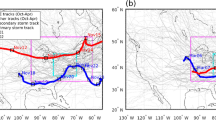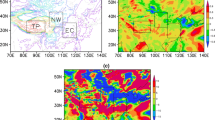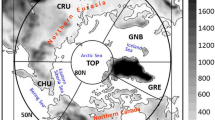Abstract
Significant changes have occurred in the Antarctic Peninsula (AP) including warmer temperatures, accelerated melting of glaciers, and breakup of ice shelves. This study uses the Weather Research and Forecasting model (WRF) forced by the Community Climate System Model 4 (CCSM) simulations to study foehn wind warming in AP. Weather systems responsible for generating the foehn events are two cyclonic systems that move toward and/or cross over AP. WRF simulates the movement of cyclonic systems and the resulting foehn wind warming that is absent in CCSM. It is found that the warming extent along a transect across the central AP toward Larsen C Ice Shelf (LCIS) varies during the simulation period and the maximum warming moves from near the base of leeward slopes to over 40 km away extending toward the attached LCIS. Our analysis suggests that the foehn wind warming is negatively correlated with the incoming air temperature and the mountain top temperature during periods without significant precipitation, in which isentropic drawdown is the dominant heating mechanism. On the other hand, when significant precipitation occurs along the windward side of AP, latent heating is the major heating mechanism evidenced by positive relations between the foehn wind warming and 1) incoming air temperature, 2) windward precipitation, and 3) latent heating. Foehn wind warming caused by isentropic drawdown also tends to be stronger than that caused by latent heating. Comparison of WRF simulations forced by original and corrected CCSM data indicates that foehn wind warming is stronger in the original CCSM forced simulation when no significant windward precipitation is present. The foehn wind warming becomes weaker in both simulations when there is significant windward precipitation. This suggests that model’s ability to resolve the foehn warming varies with the forcing data, but the precipitation impact on the leeward warming is consistent.
Similar content being viewed by others
Change history
01 July 2019
This erratum is to report a figure error in Zhang and Zhang (2018) entitled “Modeling Study of Foehn Wind Events in Antarctic Peninsula with WRF Forced by CCSM”. In Zhang and Zhang (2018), Figs. 7c, e (left panels below) should be replaced by Figs. 7*c, e (right panels below) here.
References
Barry, R. G., 2008: Mountain Weather and Climate. 3rd Ed., Cambridge University Press, Cambridge, 171 pp.
Cape, M. R., M. Vernet, P. Skvarca, et al., 2015: Foehn winds link climate-driven warming to ice shelf evolution in Antarctica. J. Geophys. Res. Atmos., 120, 11037–11057, doi: 10.1002/2015JD023465.
Chen, F., and J. Dudhia, 2001: Coupling an advanced land surfacehydrology model with the Penn State-NCAR MM5 modeling system. Part I: Model implementation and sensitivity. Mon. Wea. Rev., 129, 569–585, doi: 10.1175/1520-0493(2001) 129<0569:CAALSH>2.0.CO;2.
Cook, A. J., and D. G. Vaughan, 2010: Overview of areal changes of the ice shelves on the Antarctic Peninsula over the past 50 years. Cryosphere, 4, 77–98, doi: 10.5194/tc-4-77-2010.
Cook, A. J., A. J. Fox, D. G. Vaughan, et al., 2005: Retreating glacier fronts on the Antarctic Peninsula over the past half-century. Science, 308, 541–544, doi: 10.1126/science.1104235.
Elvidge, A. D., and I. A. Renfrew, 2016: The causes of foehn warming in the lee of mountains. Bull. Amer. Meteor. Soc., 97, 455–466, doi: 10.1175/BAMS-D-14-00194.1.
Elvidge, A. D., I. A. Renfrew, J. C. King, et al., 2016: Foehn warming distributions in nonlinear and linear flow regimes: A focus on the Antarctic Peninsula. Quart. J. Roy. Meteor. Soc., 142, 618–631, doi: 10.1002/qj.2489.
Grosvenor, D. P., J. C. King, T. W. Choularton, et al., 2014: Downslope föhn winds over the Antarctic Peninsula and their effect on the Larsen ice shelves. Atmos. Chem. Phys., 14, 9481–9509, doi: 10.5194/acp-14-9481-2014.
Hogg, A. E., and G. H. Gudmundsson, 2017: Impacts of the Larsen-C ice shelf calving event. Nature Climate Change, 7, 540–542, doi: 10.1038/nclimate3359.
Hong, S. Y., Y. Noh, and J. Dudhia, 2006: A new vertical diffusion package with an explicit treatment of entrainment processes. Mon. Wea. Rev., 134, 2318–2341, doi: 10.1175/MWR 3199.1.
Iacono, M. J., J. S. Delamere, E. J. Mlawer, et al., 2008: Radiative forcing by long-lived greenhouse gases: Calculations with the AER radiative transfer models. Geophys. Res. Lett., 113, D13103, doi: 10.1029/2008JD009944.
Kain, J. S., 2004: The Kain-Fritsch convective parameterization: An update. J. Appl. Meteor., 43, 170–181, doi: 10.1175/1520-0450(2004)043<0170:TKCPAU>2.0.CO;2.
Marshall, G. J., A. Orr, N. P. M. van Lipzig, et al., 2006: The impact of a changing Southern Hemisphere Annular Mode on Antarctic Peninsula summer temperatures. J. Climate, 19, 5388–5404, doi: 10.1175/JCLI3844.1.
Morrison, H., G. Thompson, and V. Tatarskii, 2009: Impact of cloud microphysics on the development of trailing stratiform precipitation in a simulated squall line: Comparison of oneand two-moment schemes. Mon. Wea. Rev., 137, 991–1007, doi: 10.1175/2008MWR2556.1.
Munneke, P. K., M. R. van den Broeke, J. C. King, et al., 2012: Near-surface climate and surface energy budget of Larsen C ice shelf, Antarctic Peninsula. Cryosphere, 6, 353–363, doi: 10.5194/tc-6-353-2012.
Orr, A., D. Cresswell, G. J. Marshall, et al., 2004: A ‘low-level’ explanation for the recent large warming trend over the western Antarctic Peninsula involving blocked winds and changes in zonal circulation. Geophys. Res. Lett., 31, L06204, doi: 10.1029/2003GL019160.
Orr, A., G. J. Marshall, J. C. R. Hunt, et al., 2008: Characteristics of summer airflow over the Antarctic Peninsula in response to recent strengthening of westerly circumpolar winds. J. Atmos. Sci., 65, 1396–1413, doi: 10.1175/2007JAS2498.1.
Paulson, C. A., 1970: The mathematical representation of wind speed and temperature profiles in the unstable atmospheric surface layer. J. Appl. Meteor., 9, 857–861, doi: 10.1175/1520-0450(1970)009<0857:TMROWS>2.0.CO;2.
Pritchard, H. D., R. J. Arthern, D. G. Vaughan, et al., 2009: Extensive dynamic thinning on the margins of the Greenland and Antarctic ice sheets. Nature, 461, 971–975, doi: 10.1038/nature08471.
Rignot, E., J. L. Bamber, M. R. van den Broeke, et al., 2008: Recent Antarctic ice mass loss from radar interferometry and regional climate modelling. Nature Geoscience, 1, 106–110, doi: 10.1038/ngeo102.
Scambos, T. A., C. Hulbe, M. Fahnestock, et al., 2000: The link between climate warming and break-up of ice shelves in the Antarctic Peninsula. J. Glaciology, 46, 516–530, doi: 10.3189/172756500781833043.
Shepherd, A., D. Wingham, T. Payne, et al., 2003: Larsen ice shelf has progressively thinned. Science, 302, 856–859, doi: 10.1126/science.1089768.
van den Broeke, M., 2005: Strong surface melting preceded collapse of Antarctic Peninsula ice shelf. Geophys. Res. Lett., 32, L12815, doi: 10.1029/2005GL023247.
van Lipzig, N. P. M., G. J. Marshall, A. Orr, et al., 2008: The relationship between the Southern Hemisphere annular mode and Antarctic Peninsula summer temperatures: Analysis of a highresolution model climatology. J. Climate, 21, 1649–1668, doi: 10.1175/2007JCLI1695.1.
Vaughan, D. G., 2006: Recent trends in melting conditions on the Antarctic Peninsula and their implications for ice-sheet mass balance and sea level. Arct. Antarct. Alp. Res., 38, 147–152, doi: 10.1657/1523-0430(2006)038[0147:RTIMCO]2.0.CO;2.
Vaughan, D. G., G. J. Marshall, W. M. Connolley, et al., 2003: Recent rapid regional climate warming on the Antarctic Peninsula. Climatic Change, 60, 243–274, doi: 10.1023/A:10260 21217991.
Author information
Authors and Affiliations
Corresponding author
Rights and permissions
About this article
Cite this article
Zhang, C., Zhang, J. Modeling Study of Foehn Wind Events in Antarctic Peninsula with WRF Forced by CCSM. J Meteorol Res 32, 909–922 (2018). https://doi.org/10.1007/s13351-018-8067-9
Received:
Accepted:
Published:
Issue Date:
DOI: https://doi.org/10.1007/s13351-018-8067-9




